How to Tow a Car with a Truck: A Step-by-Step Guide
January 14, 2023
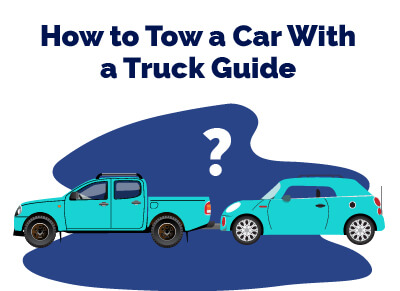

I am a serial entrepreneur and a consumer advocate. When I’m not helping car buyers, I love working on ventures that have a positive impact.
I run a cause marketing agency and serve on the board of Vayu Global Health where we are disrupting the medical industry and preventing the needless deaths of mothers and babies during childbirth.
Towing a car with a truck is an efficient way to move your vehicle from one place to another, but it requires the right equipment and knowledge. To make sure you do it safely and effectively, there are certain things you need to consider before taking on this task.
Follow these steps and ensure success every time!
Table of Contents
What You Need to Tow a Car with a Truck
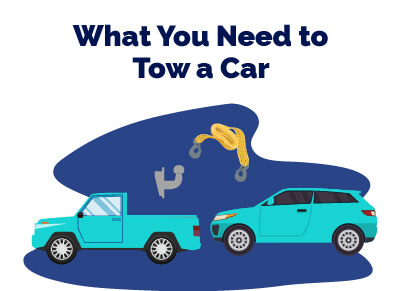 However, it’s important to make sure you have the right equipment and safety considerations in place before attempting this task.
However, it’s important to make sure you have the right equipment and safety considerations in place before attempting this task.
Truck Requirements
The first step is making sure your truck has the necessary power and capacity for towing. The vehicle must be equipped with a tow hitch that can handle the weight of the towed vehicle, as well as any additional cargo or supplies you may need during your trip. Additionally, check that your truck’s brakes are up-to-date and functioning properly since they will be responsible for stopping both vehicles while on the road.
Towing Equipment
You will also need specialized equipment for safely connecting your two vehicles together. This includes items such as a tow bar, safety chains, wheel chocks, and other accessories designed specifically for hauling cars behind trucks. Make sure all of these pieces are rated for use with heavy loads before purchasing them so you know they won’t fail while in transit.
Safety Considerations
Towing a car with a truck requires the right equipment, and it is important to take safety precautions when doing so. Once you have gathered the necessary items, you can move on to hooking up the vehicle for towing.
Key Takeaway: When towing a car with a truck, it is important to ensure the vehicle has adequate power and capacity for the load, as well as up-to-date brakes. Additionally, specialized equipment such as tow bars, safety chains, and wheel chocks should be used for safely connecting the two vehicles together.
How to Hook Up the Vehicle for Towing
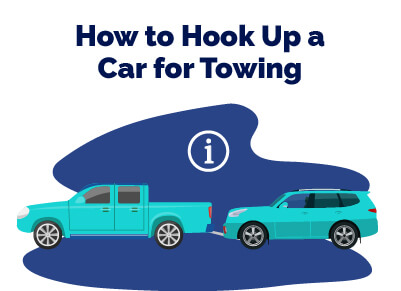 Before you can hook up your vehicle to be towed, there are a few steps that must be taken. First, make sure the car is in park and the emergency brake is engaged. This will help ensure it stays securely in place while being towed. If you have an automatic transmission, you may also need to put it into neutral before engaging the tow bar. It’s also important to check all of your fluid levels before beginning any kind of tow job; this includes oil, coolant, and power steering fluid.
Before you can hook up your vehicle to be towed, there are a few steps that must be taken. First, make sure the car is in park and the emergency brake is engaged. This will help ensure it stays securely in place while being towed. If you have an automatic transmission, you may also need to put it into neutral before engaging the tow bar. It’s also important to check all of your fluid levels before beginning any kind of tow job; this includes oil, coolant, and power steering fluid.
Once everything has been checked over on both vehicles (the one being towed and the one doing the towing), it’s time to connect them together with a tow bar or dolly system.
Start by attaching each end of the tow bar or dolly system onto their respective hitch receivers—usually located at either end of both cars—then secure them tightly with pins or clips so they don’t come loose during transit.
Finally, attach safety chains between both vehicles as an extra precaution against separation if something were to go wrong during transport.
After connecting both vehicles together with a tow bar or dolly system and securing them with safety chains, it is time to secure your vehicle for transport by tying down its front wheels using wheel straps or chocks placed behind each tire on either side of your car's axle line (if applicable).
Make sure these straps are tight enough that they won't slip off but not too tight that they cause damage when driving over bumps in the road; adjust accordingly until properly secured.
Once the vehicle is properly hooked up to the tow bar and safety chains, it's time to learn some driving tips for safely towing a car with a truck.
Key Takeaway: Before towing a car, it is important to: engage the emergency brake; check all fluid levels; attach tow bar or dolly system and safety chains; secure front wheels with wheel straps or chocks.
Driving Tips for Towing a Car with a Truck
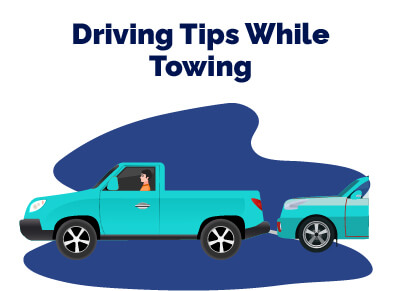
It is important to understand the proper techniques and safety precautions that should be taken when towing a vehicle. Here are some tips on how to adjust your driving style, braking, and turning techniques, as well as properly loading cargo in your truck bed when you’re hauling a car behind you.
Adjusting Your Driving Style for Towing
When you're towing something heavy like a car, it's important to make sure that you drive more slowly than usual and avoid sudden acceleration or deceleration. You'll also want to leave plenty of space between yourself and other vehicles so that if any unexpected stops need to be made, there will be enough room for both vehicles involved in the tow.
Braking should also be done gradually so that the towed vehicle doesn't jerk forward too quickly or cause any damage due to excessive force being applied by the brakes.
Braking and Turning Techniques for Towing
When braking while hauling a car behind your truck, it's important not only to apply pressure gradually but also evenly across all four wheels of both vehicles involved in the tow. This helps ensure that neither vehicle loses control during stopping maneuvers or turns at intersections or curves in the road.
Additionally, when making turns while pulling another vehicle behind you, it's best practice not only turn wide but also reduce speed before entering each turn as this will help keep both cars stable throughout their journey together down the roadways ahead of them.
It is important to take the time to familiarize yourself with the proper driving techniques for safely and securely towing a car with a truck. Now that you have learned more about driving tips, let's move on to discuss some maintenance tips for successful car-towing trips.
Key Takeaway: When towing a car with your truck, it is important to adjust your driving style by slowing down and avoiding sudden acceleration or deceleration. Additionally, proper braking and turning techniques should be used such as applying pressure gradually across all four wheels of both vehicles involved in the tow, as well as reducing speed before entering into each turn.
Maintenance Tips for Towing a Car with a Truck
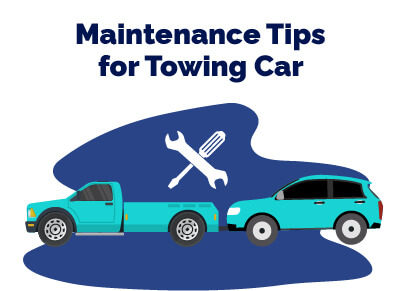
Here are some tips for maintaining your tow equipment and vehicle setup when towing a car with a truck.
Regularly Inspecting Your Tow Equipment and Vehicle Setup: It's important to regularly inspect all of the components of your tow equipment, such as the hitch, ball mount, chains or straps, safety cables, electrical connections, brakes (if applicable), and tires.
Make sure that all parts are securely attached and free from damage or corrosion. Additionally, check that the tongue weight is properly distributed between the trailer axle(s) and the tow vehicle’s rear axle(s).
Checking Tire Pressure and Alignment Before Each Trip: Before each trip you should check both your truck’s tire pressure as well as its alignment. Low tire pressure can cause excessive heat buildup which can lead to blowouts on long trips; therefore it’s important to make sure that all tires have adequate air pressure before heading out on any journey.
In addition to checking tire pressure you should also make sure that your truck has good wheel alignment so that it tracks straight while pulling a load down the road.
Checking Fluid Levels Regularly: When hauling heavy loads over long distances, it is important to keep an eye on fluid levels such as engine oil level, transmission fluid level (for automatic transmissions), power steering fluid level (for power steering systems), coolant/antifreeze level (for cooling systems), brake fluid level (for hydraulic brakes), etc., since these fluids may need topping off more frequently than usual due to increased wear-and-tear during longer trips.
By following these simple maintenance tips for safely transporting cars using trucks, you can ensure safe travels for yourself and those around you.
Key Takeaway: To ensure safety and reliability when towing a car with a truck, it is important to regularly inspect the tow equipment and vehicle setup, check tire pressure and alignment before each trip, and monitor fluid levels during longer trips.
Troubleshooting Common Issues When Towing a Car with a Truck
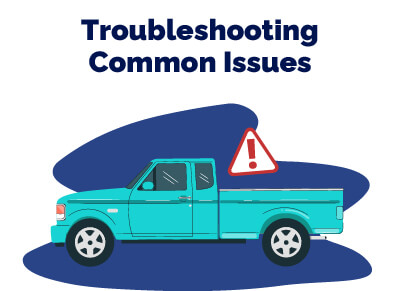
Troubleshooting common issues when towing a car with a truck can be tricky, but there are some steps you can take to make sure everything goes smoothly.
Dealing With Unbalanced Loads or Poor Weight Distribution: When towing a car with your truck, it is important that the load is balanced and distributed properly. If the weight of the vehicle being towed is not evenly distributed across both axles of your truck, it could cause problems such as swaying or instability while driving.
To prevent this from happening, use wheel chocks on each side of the tires and secure them tightly so they don’t move around during transit. You should also check that all safety chains are connected correctly before starting out on your journey.
Addressing Overheating Engines or Exhaust Systems: Towing an extra vehicle behind your truck puts additional strain on its engine and exhaust system which can lead to overheating if not managed properly. Make sure you keep an eye on temperatures while driving by checking gauges regularly and pull over if necessary for cooling-off periods. Also ensure that any air vents in front of the radiator are clear from debris as these will help keep airflow going through the engine bay and reduce heat build-up.
Before setting off, double-check all connections between vehicles including battery terminals, ground wires, turn signal lights etc., making sure they are securely fastened together without any loose ends exposed where moisture could enter into them causing corrosion damage down the line.
Additionally, it is important to ensure that all electrical components are functioning properly and that there is no dimming of headlights or flickering of taillights as this can be dangerous for other drivers on the road at night time.
Key Takeaway: To ensure a safe and successful towing experience, make sure your load is balanced and distributed properly, keep an eye on temperatures while driving, double check all connections between vehicles for secure fastening and proper functioning of electrical components.
Best Car Deals by Category
Frequently Asked Questions
How can I tow my car myself?
Towing your car yourself is possible, but it requires the right equipment and preparation. Before attempting to tow your car, you should make sure that you have a reliable tow rope or chain, as well as a set of wheel chocks to prevent the vehicle from rolling while being towed. Additionally, you will need an appropriate hitch for both vehicles involved in the tow. Once everything is ready, attach one end of the rope or chain to the back of your vehicle and secure it with a knot before attaching it to the other vehicle's hitch. Make sure that all connections are tight and secure before beginning to drive away slowly. Finally, be mindful of speed limits when driving and ensure that you stop frequently if necessary for safety reasons.
What is the easiest way to tow a car?
The easiest way to tow a car is by using a tow dolly. A tow dolly is an affordable, lightweight device that can be used to safely and securely transport one vehicle behind another. It attaches to the back of the vehicle being towed and supports two of its wheels while allowing the other two wheels to remain on the ground. This method eliminates any risk of damage caused by dragging or flat-towing, making it much easier than traditional methods such as flat-bedding or winching. Additionally, it requires minimal setup time and can be quickly disconnected when no longer needed.
Is it hard to tow a car behind a moving truck?
Towing a car behind a moving truck is not difficult, but it does require some preparation and care. First, you should check the towing capacity of your truck to make sure it can handle the weight of the car being towed. You'll also need tow straps or chains that are rated for the weight of your vehicle, as well as an appropriate hitch and ball mount. Finally, you'll want to ensure that all four wheels on the car being towed are securely off the ground before beginning your journey. With these steps taken into consideration, towing a car behind a moving truck is relatively straightforward and safe.
Can a 1500 truck tow a car?
Yes, a 1500 truck can tow a car. The towing capacity of the vehicle will depend on the engine size and other factors such as transmission type, axle ratio, suspension system, and more. It is important to consult your owner's manual or speak with an automotive professional before attempting to tow any vehicle with your 1500 truck. Knowing the weight of both vehicles involved in the process is also essential for safe towing.
Posted in Car Buying Tips |




